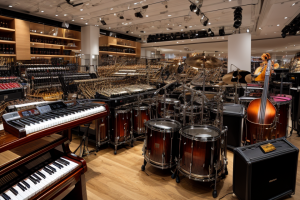
The global market for musical instruments is a thriving industry that spans across continents and cultures. From the traditional wooden flute of India to the electric guitar of the United States, musical instruments play a vital role in the expression of art and culture. This industry is a complex network of manufacturers, retailers, and distributors that cater to the needs of professional musicians, hobbyists, and enthusiasts alike. The market is driven by a range of factors, including technological advancements, changing consumer preferences, and globalization. In this article, we will explore the trends, opportunities, and challenges that shape the global market for musical instruments. Join us as we embark on a journey to discover the exciting world of music and commerce.
The Musical Instrument Market: An Overview
The Evolution of the Musical Instrument Market
The musical instrument market has undergone significant evolution over the years, driven by a range of factors such as technological advancements, changing consumer preferences, and global economic trends.
One of the most notable evolutions in the musical instrument market has been the increasing popularity of digital and electronic instruments. These instruments have gained popularity due to their portability, affordability, and the ability to replicate a wide range of sounds. As a result, traditional acoustic instruments have faced increased competition from their digital counterparts.
Another key trend in the musical instrument market has been the growth of online sales channels. The rise of e-commerce platforms and online marketplaces has made it easier for consumers to purchase musical instruments from anywhere in the world. This has led to increased competition among traditional brick-and-mortar retailers, who have had to adapt to the changing market landscape in order to remain competitive.
The globalization of the musical instrument market has also created new opportunities for manufacturers and retailers. As musical instruments become more accessible to people around the world, there is a growing demand for a wider range of instruments and accessories. This has led to the development of new products and the expansion of existing product lines.
However, the evolution of the musical instrument market has also presented challenges for manufacturers and retailers. One of the biggest challenges has been the rise of counterfeit products, which can undermine the market for legitimate musical instruments. Additionally, changes in trade policies and tariffs can have a significant impact on the cost and availability of musical instruments, particularly for smaller manufacturers and retailers.
Overall, the evolution of the musical instrument market has been driven by a range of factors, including technological advancements, changing consumer preferences, and global economic trends. While these trends have created new opportunities for manufacturers and retailers, they have also presented challenges that must be addressed in order to ensure the continued growth and success of the market.
The Structure of the Musical Instrument Market
The musical instrument market is a diverse and complex industry, encompassing a wide range of products, from guitars and pianos to drums and brass instruments. The structure of the market can be analyzed in terms of its segmentation, distribution channels, and competitive landscape.
Segmentation
The musical instrument market can be segmented based on product type, end-use, and geography. By product type, the market is divided into string instruments, percussion instruments, woodwinds, brass instruments, and keyboards. Each of these categories has its own unique characteristics and target audience, and the market for each instrument can be influenced by factors such as consumer preferences, technological advancements, and cultural trends.
Distribution Channels
The distribution channels for musical instruments are diverse and include both online and offline channels. Traditional brick-and-mortar stores such as music shops and department stores remain popular for many consumers, while e-commerce platforms and online marketplaces have gained significant traction in recent years. Direct-to-consumer sales channels, such as artist websites and social media platforms, have also emerged as important channels for reaching consumers.
Competitive Landscape
The musical instrument market is highly competitive, with a large number of players operating in the market. Major players include established brands such as Yamaha, Gibson, and Steinway, as well as smaller independent manufacturers and retailers. The market is characterized by intense competition for market share, with companies competing on factors such as product quality, price, and innovation. Additionally, the rise of online marketplaces and e-commerce platforms has disrupted traditional distribution channels and created new opportunities for both established and emerging players.
Overall, understanding the structure of the musical instrument market is crucial for companies looking to enter or compete in this industry. By analyzing the segmentation, distribution channels, and competitive landscape, companies can identify opportunities for growth and differentiation, as well as challenges that must be addressed in order to succeed in this dynamic and highly competitive market.
Market Segmentation: Instruments and Regions
When analyzing the global market for musical instruments, it is crucial to understand the segmentation of the market based on both instruments and regions. This segmentation allows for a more detailed examination of the market trends, opportunities, and challenges in each category.
Instrument Segmentation
The market for musical instruments can be segmented based on the type of instrument, such as string instruments (e.g., violins, cellos, and guitars), woodwind instruments (e.g., flutes, clarinets, and saxophones), brass instruments (e.g., trumpets, trombones, and tubas), percussion instruments (e.g., drums and xylophones), and keyboards (e.g., pianos and synthesizers). Each of these instrument categories has unique characteristics, target demographics, and price points, which can influence consumer behavior and market dynamics.
For example, string instruments are often associated with classical music and have a more niche market compared to instruments like keyboards or percussion, which are more commonly used in various genres of popular music. Similarly, high-end brass and woodwind instruments may cater to professional musicians or music conservatories, while entry-level instruments can be targeted towards beginners or hobbyists.
Regional Segmentation
The global market for musical instruments can also be segmented by geographic region, such as North America, Europe, Asia-Pacific, Latin America, and the Middle East and Africa. Each region has its own unique cultural and economic factors that influence the demand for musical instruments and the competitive landscape of the market.
For instance, North America and Europe are historically significant markets for musical instruments, with strong demand for high-quality instruments and a focus on classical music. Asia-Pacific, on the other hand, has a growing market for musical instruments, driven by increasing interest in Western classical music and the rise of popular music genres such as K-pop and J-pop. Latin America and the Middle East and Africa also have emerging markets for musical instruments, with a growing interest in Western classical music and a desire for locally produced instruments.
Understanding the segmentation of the musical instrument market by instruments and regions is crucial for businesses looking to enter or expand in the market. By analyzing the specific trends, opportunities, and challenges in each segment, companies can develop targeted strategies to capitalize on market growth and effectively compete in the global musical instrument industry.
Market Trends
Technological Advancements in Musical Instruments
In recent years, the musical instrument industry has seen significant technological advancements. These advancements have transformed the way musical instruments are designed, manufactured, and marketed. Here are some of the key trends in technological advancements in musical instruments:
- Electronic Instruments: Electronic instruments such as digital pianos, synthesizers, and drum machines have become increasingly popular in recent years. These instruments offer a range of features that traditional acoustic instruments cannot match, such as the ability to create and store different sounds, connect to other devices, and use apps and software to enhance their functionality.
- Virtual Instruments: Virtual instruments, also known as software instruments, are becoming more popular as technology improves. These instruments use software to simulate the sound and feel of traditional instruments, allowing musicians to play and record without the need for physical instruments.
- 3D Printing: 3D printing technology has enabled manufacturers to create musical instruments with greater precision and customization. This technology allows for the creation of complex shapes and designs that would be difficult or impossible to produce using traditional manufacturing methods.
- Sensors and Sensors Technology: Sensors and sensor technology have become an integral part of modern musical instruments. They allow for greater control over sound and tone, as well as providing data on playing technique and performance.
- Augmented Reality: Augmented reality technology is being used to enhance the playing and learning experience for musicians. This technology allows musicians to see and interact with virtual instruments and sheet music, providing a more immersive and interactive experience.
Overall, these technological advancements have transformed the musical instrument industry, providing new opportunities for manufacturers and musicians alike. However, they also present challenges, such as the need to adapt to new technologies and keep up with rapidly changing trends.
Sustainability and Environmental Concerns
The global market for musical instruments is increasingly being influenced by sustainability and environmental concerns. As consumers become more aware of the impact of their purchasing decisions on the environment, there is a growing demand for eco-friendly and sustainable musical instruments. This trend is driven by several factors, including:
- Government regulations: Governments around the world are implementing regulations aimed at reducing the environmental impact of the music industry. For example, the European Union’s Waste Electrical and Electronic Equipment Directive (WEEE) requires manufacturers to take responsibility for the environmental impact of their products throughout their entire life cycle.
- Consumer demand: Consumers are increasingly demanding eco-friendly and sustainable products, including musical instruments. This is particularly true among younger generations who are more environmentally conscious.
- Sustainable materials: Many manufacturers are turning to sustainable materials to produce musical instruments. For example, some guitar makers are using reclaimed wood for their instruments, while others are using sustainably sourced woods.
- Recycling and upcycling: Some manufacturers are exploring recycling and upcycling as a way to reduce waste and minimize their environmental impact. For example, some companies are recycling old instruments and giving them new life, while others are using recycled materials to create new instruments.
Despite these efforts, the music industry still faces significant challenges in becoming more sustainable. For example, the manufacturing process for musical instruments can be resource-intensive, and there is a lack of standardization in sustainability practices across the industry. However, as sustainability and environmental concerns continue to gain importance among consumers and governments, it is likely that the music industry will need to adapt and become more environmentally friendly in order to remain competitive.
Increasing Demand for Digital Musical Instruments
In recent years, there has been a noticeable shift in the demand for musical instruments, particularly towards digital instruments. This trend can be attributed to several factors, including advancements in technology, the convenience and accessibility of digital instruments, and the growing popularity of electronic music.
Technological Advancements
The development of digital technology has played a significant role in the increasing demand for digital musical instruments. Digital instruments, such as virtual pianos and digital drums, offer a wide range of features and capabilities that traditional acoustic instruments cannot match. For example, digital pianos can simulate the sound of different types of acoustic pianos, allowing players to experiment with different tones and textures. Digital drums, on the other hand, can provide a vast array of drum sounds and rhythms, making them a popular choice among drummers.
Convenience and Accessibility
Another factor contributing to the popularity of digital musical instruments is their convenience and accessibility. Digital instruments are often more portable and lightweight than their acoustic counterparts, making them easy to transport and set up. Additionally, digital instruments require less maintenance and upkeep, as they do not need to be tuned or cleaned like traditional instruments.
Furthermore, digital instruments offer a wide range of features that make them more accessible to players of all skill levels. For example, many digital pianos come with built-in learning tools, such as lesson modes and metronomes, which can help beginners improve their skills. Additionally, digital instruments can be used with a variety of apps and software, allowing players to expand their musical horizons and explore new genres and styles.
Growing Popularity of Electronic Music
Finally, the growing popularity of electronic music has also contributed to the increasing demand for digital musical instruments. Electronic music producers and performers often rely on digital instruments, such as synthesizers and samplers, to create their music. As a result, there has been a surge in the popularity of digital instruments among musicians and producers working in the electronic music genre.
Overall, the increasing demand for digital musical instruments is a trend that is likely to continue in the coming years. As technology continues to advance and the popularity of electronic music grows, it is likely that more and more musicians will turn to digital instruments as their instrument of choice.
Market Opportunities
Emerging Markets for Musical Instruments
As the demand for musical instruments continues to grow globally, emerging markets present significant opportunities for manufacturers and retailers. These markets, characterized by increasing disposable income, rising cultural awareness, and growing interest in music, offer a potential customer base for musical instruments. To tap into these emerging markets, manufacturers and retailers must consider the unique characteristics of each market, such as cultural preferences, pricing, and distribution channels.
Some of the emerging markets for musical instruments include:
- China: With a population of over 1.3 billion people, China has a growing middle class that is increasingly interested in music education and musical instrument ownership. The Chinese government’s focus on music education in schools has also contributed to the growth of the market. However, the market is highly competitive, with both domestic and international manufacturers vying for market share.
- India: India’s growing middle class and increasing interest in Western music have created a demand for musical instruments. The market is primarily driven by demand for traditional Indian instruments, such as the sitar and tabla, as well as Western instruments like guitars and keyboards.
- Southeast Asia: Countries like Indonesia, Malaysia, and the Philippines have a growing interest in music, driven by a younger population with access to Western music through the internet. This has created a demand for musical instruments, particularly guitars and keyboards.
- Africa: As the African economy continues to grow, there is an increasing interest in music and musical instruments. The market is primarily driven by demand for traditional African instruments, such as the djembe and kora, as well as Western instruments like guitars and keyboards.
To succeed in these emerging markets, manufacturers and retailers must be prepared to adapt to local preferences and customs. This may include offering a wide range of products that cater to different cultural tastes, providing local language support, and establishing partnerships with local distributors and retailers. Additionally, manufacturers and retailers must be prepared to navigate complex regulatory environments and manage supply chain logistics in these markets.
In conclusion, emerging markets present significant opportunities for manufacturers and retailers of musical instruments. However, success in these markets requires a deep understanding of local preferences, customs, and regulations, as well as the ability to adapt to the unique characteristics of each market.
Collaborations and Partnerships in the Musical Instrument Industry
In recent years, the musical instrument industry has seen a rise in collaborations and partnerships between manufacturers, retailers, and other stakeholders. These collaborations and partnerships offer several benefits to the companies involved, including increased market reach, improved product offerings, and cost savings.
One example of a successful collaboration in the musical instrument industry is the partnership between Yamaha and Nintendo for the development of the popular game, “Mario Kart 8.” This collaboration allowed Yamaha to leverage Nintendo’s expertise in video game development, while also expanding its reach into the gaming market.
Another example of a successful partnership in the musical instrument industry is the collaboration between Fender and Squier. Fender, a well-known manufacturer of electric guitars and basses, partnered with Squier to produce a line of affordable, high-quality instruments. This partnership allowed Fender to expand its product offerings while also maintaining its reputation for quality and innovation.
In addition to these examples, there are many other collaborations and partnerships in the musical instrument industry that offer opportunities for growth and success. For example, some manufacturers are partnering with music schools and conservatories to provide instruments and support for music education programs. Other companies are collaborating with technology firms to develop new products and improve the customer experience.
Overall, collaborations and partnerships in the musical instrument industry offer many opportunities for growth and success. By working together, companies can leverage each other’s strengths, expand their reach, and develop innovative new products that meet the needs of musicians and music lovers around the world.
Niche Markets and Customization
One of the key opportunities in the global market for musical instruments is the emergence of niche markets and the growing demand for customization. In recent years, there has been a shift towards more specialized and unique musical instruments, as well as a growing interest in personalizing and customizing existing instruments.
Growing Interest in Traditional and Ethnic Instruments
There has been a significant increase in the popularity of traditional and ethnic musical instruments in recent years. This trend is driven by a growing interest in cultural diversity and the desire to explore different musical traditions. As a result, there is a growing demand for traditional instruments such as the sitar, oud, and koto, as well as lesser-known instruments from around the world.
Customization and Personalization
Another trend in the market for musical instruments is the growing demand for customization and personalization. Musicians and music enthusiasts are increasingly looking for unique and personalized instruments that reflect their individuality and style. This has led to a rise in the number of artisans and craftsmen who specialize in customizing and modifying existing instruments, as well as building new ones from scratch.
Emphasis on Quality and Craftsmanship
The growing demand for customization and personalization has also led to a renewed emphasis on quality and craftsmanship in the market for musical instruments. Consumers are increasingly willing to pay a premium for instruments that are crafted with care and attention to detail, using high-quality materials and traditional manufacturing techniques. This has created opportunities for artisans and manufacturers who specialize in handcrafted instruments and who can offer a level of quality and craftsmanship that is difficult to find in mass-produced instruments.
Online Platforms and Communities
Finally, the growth of online platforms and communities has played a significant role in facilitating the emergence of niche markets and the demand for customization in the global market for musical instruments. Online marketplaces and social media platforms have made it easier for musicians and music enthusiasts to connect with artisans and craftsmen, and to access a wider range of instruments and customization options than ever before. This has helped to fuel the growth of niche markets and the demand for customization, and is likely to continue to play a significant role in shaping the future of the market for musical instruments.
Market Challenges
Intellectual Property Rights and Counterfeit Products
Intellectual property rights (IPR) are a significant challenge in the global market for musical instruments. Companies that invest time and resources into developing innovative products, such as new types of instruments or cutting-edge technologies, must protect their intellectual property from being copied or counterfeited. This can be particularly difficult in markets where IPR enforcement is weak or where there is a culture of piracy.
One of the main issues with counterfeit products is that they can significantly undermine the legitimate market for musical instruments. When consumers can purchase a low-quality imitation of a product for a fraction of the price of the genuine article, they may be tempted to choose the counterfeit product instead. This can lead to lost sales and revenue for legitimate manufacturers, and it can also damage the reputation of the brand.
In addition to the direct impact on sales, counterfeit products can also create challenges for the development of new products. Companies that invest in research and development may be hesitant to introduce new products if they fear that their intellectual property will be quickly copied and sold by counterfeiters. This can stifle innovation and limit the range of products available to consumers.
To address these challenges, companies can take a number of steps. For example, they can invest in protecting their intellectual property through patents, trademarks, and other legal mechanisms. They can also work with law enforcement agencies and other stakeholders to identify and seize counterfeit products. Finally, they can work to educate consumers about the risks of purchasing counterfeit products and the importance of supporting legitimate manufacturers.
Economic Factors and Fluctuations
Economic factors and fluctuations pose significant challenges to the global market for musical instruments. The market is highly dependent on consumer spending, which is influenced by economic conditions such as recessions, inflation, and currency exchange rates. These factors can impact the purchasing power of consumers, leading to a decrease in demand for musical instruments.
During a recession, consumers tend to cut back on non-essential spending, including purchases of musical instruments. This can result in a decline in sales for manufacturers and retailers, making it difficult for them to maintain profitability. Similarly, inflation can lead to an increase in the cost of raw materials and production, resulting in higher prices for musical instruments and a decline in demand.
Currency exchange rates can also have a significant impact on the global market for musical instruments. A strong currency can make imports more expensive, resulting in higher prices for musical instruments. On the other hand, a weak currency can make exports more competitive, leading to increased demand for musical instruments from other countries.
Moreover, economic fluctuations can impact the supply chain of musical instruments, making it difficult for manufacturers and retailers to plan for the future. Uncertainty in the supply chain can lead to delays in production and delivery, resulting in lost sales and revenue.
In conclusion, economic factors and fluctuations pose significant challenges to the global market for musical instruments. Manufacturers and retailers must be able to adapt to changing economic conditions and find ways to mitigate the impact of these challenges on their businesses.
Environmental Regulations and Compliance
The global market for musical instruments is not without its challenges, one of which is environmental regulations and compliance. As awareness about the environmental impact of human activities grows, governments and organizations are implementing stricter regulations on the production and disposal of products, including musical instruments. This poses a significant challenge for manufacturers and retailers of musical instruments, who must comply with these regulations while still meeting the demands of their customers.
Some of the key environmental regulations that impact the musical instrument industry include:
- Restrictions on the use of certain materials: Some materials used in the production of musical instruments, such as certain types of wood and metals, are subject to restrictions due to their environmental impact. For example, the European Union’s Timber Regulation (EUTR) prohibits the placing of illegally harvested timber on the EU market, which has implications for the production of woodwind instruments.
- End-of-life disposal: Musical instruments must be disposed of properly at the end of their useful life, in accordance with local regulations. This can be a challenge for manufacturers and retailers, who must ensure that their products are disposed of in an environmentally friendly manner.
- Energy efficiency: The production of musical instruments requires a significant amount of energy, which contributes to greenhouse gas emissions. Manufacturers and retailers must comply with regulations aimed at reducing energy consumption and emissions, such as the European Union’s Energy-Related Products (ERP) regulations.
In addition to these regulations, there is also growing pressure from consumers for companies to adopt more sustainable practices. This includes using environmentally friendly materials and production methods, as well as ensuring that products are disposed of properly at the end of their useful life.
To comply with these regulations and meet the demands of their customers, manufacturers and retailers of musical instruments must take a proactive approach to sustainability. This may involve investing in new technologies and production methods, sourcing materials from sustainable sources, and developing strategies for end-of-life disposal. By doing so, they can ensure that they are able to meet the demands of the market while also protecting the environment.
The Future of the Musical Instrument Market: Prospects and Predictions
The future of the musical instrument market is marked by a combination of opportunities and challenges. While advancements in technology and changes in consumer preferences are creating new opportunities, the market also faces several challenges that may impact its growth in the coming years.
One of the significant challenges facing the musical instrument market is the increasing competition from digital music products. The growing popularity of digital music and the ease of access it provides to consumers have led to a decline in physical music sales, which in turn has affected the demand for musical instruments. Furthermore, the availability of affordable and high-quality digital musical instruments has further impacted the demand for traditional musical instruments.
Another challenge facing the musical instrument market is the changing demographics of the consumer base. With the rise of the millennial generation, there has been a shift in consumer preferences towards experiences and services over physical goods. This has led to a decline in the demand for traditional musical instruments, particularly among younger consumers. Additionally, the rise of online marketplaces and e-commerce platforms has made it easier for consumers to purchase musical instruments directly from manufacturers, which has further impacted the demand for traditional retail channels.
However, despite these challenges, the musical instrument market remains a significant and profitable industry. The increasing popularity of live music events and the growing interest in learning musical instruments among consumers present significant opportunities for growth. Furthermore, the increasing demand for high-quality musical instruments and the growing trend towards sustainable and eco-friendly products present opportunities for innovation and differentiation.
In conclusion, while the future of the musical instrument market is marked by several challenges, there are also significant opportunities for growth and innovation. Manufacturers and retailers must adapt to changing consumer preferences and embrace new technologies to remain competitive in this dynamic industry.
FAQs
1. What is the global market for musical instruments?
The global market for musical instruments is a rapidly growing industry that includes the manufacturing, distribution, and sale of a wide range of musical instruments. This market includes both traditional acoustic instruments, such as guitars and pianos, as well as electronic instruments, such as synthesizers and drum machines. The market is driven by factors such as increasing demand for musical education, rising popularity of music as a hobby, and the growth of the global music industry.
2. What are the trends in the global market for musical instruments?
One of the major trends in the global market for musical instruments is the increasing popularity of electronic instruments. As technology continues to advance, electronic instruments are becoming more sophisticated and are gaining popularity among musicians of all skill levels. Additionally, there is a growing trend towards the use of online platforms for the sale and distribution of musical instruments, which has made it easier for musicians to access a wider range of instruments and has helped to increase the accessibility of musical education.
3. What are the opportunities in the global market for musical instruments?
The global market for musical instruments presents a number of opportunities for businesses and individuals looking to enter the industry. One opportunity is the growing demand for musical education, as more and more people are seeking to learn how to play musical instruments. Additionally, there is a growing demand for high-quality, specialized instruments, such as professional-grade guitars and pianos, which presents an opportunity for businesses to differentiate themselves and cater to this niche market.
4. What are the challenges in the global market for musical instruments?
One of the major challenges in the global market for musical instruments is the high level of competition. The industry is crowded with established brands and businesses, making it difficult for new entrants to gain a foothold. Additionally, the global market for musical instruments is subject to economic fluctuations, as the demand for musical instruments is often tied to broader economic trends. Finally, there is a growing concern about the environmental impact of the manufacturing and distribution of musical instruments, which presents a challenge for businesses looking to operate sustainably.







